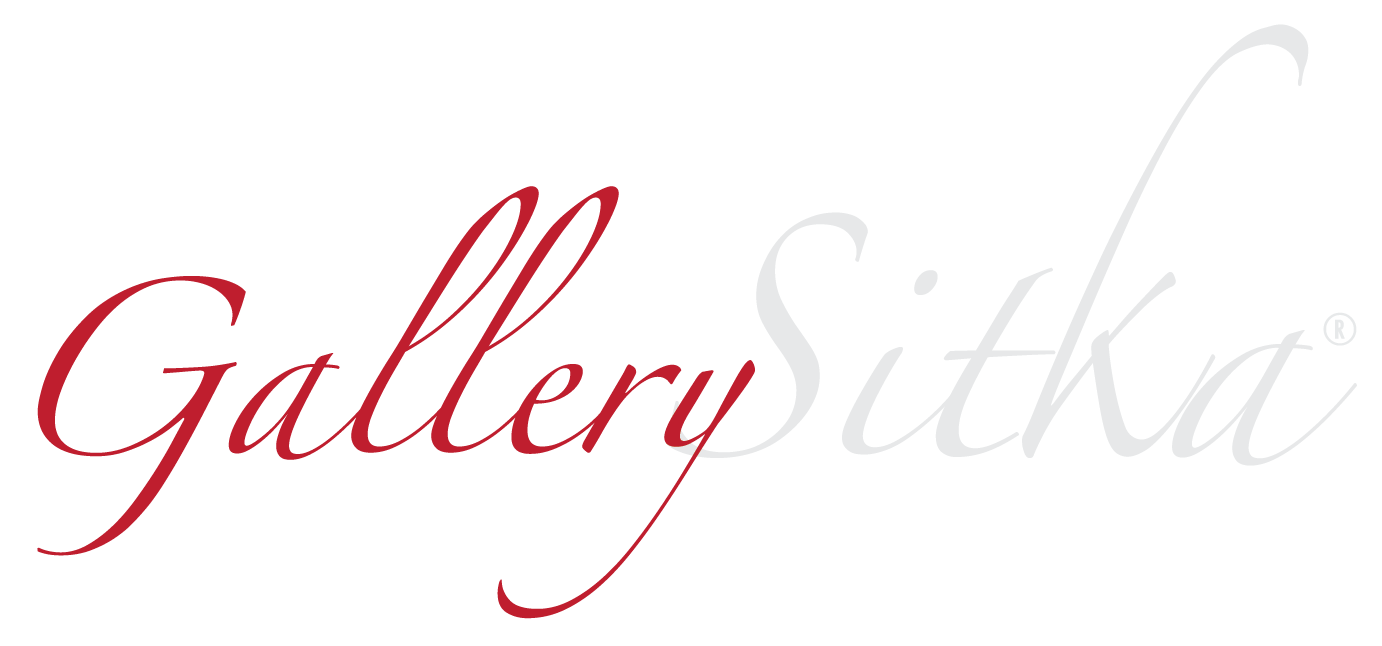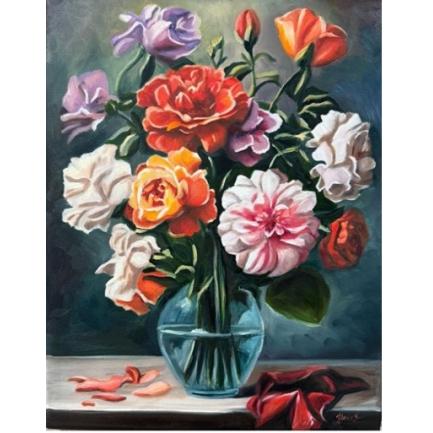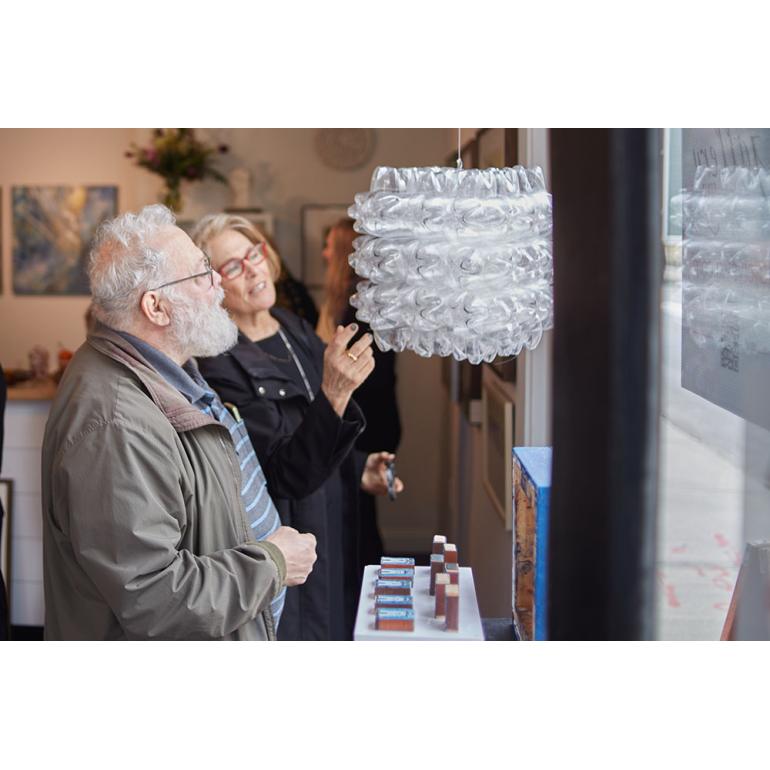FOR IMMEDIATE RELEASE
October 14, 2016
Contact: Tamar Russell Brown, Gallery Sitka — 978.425.6290
Fitchburg “Paint-In” Artists from 2007 to 2011
and Celebrated Encaustic Collagist to Exhibit at Gallery Sitka in Fitchburg
Two splendid displays of the work of many gifted artists will share Gallery Sitka beginning Saturday, Nov. 12. One exhibit will bring together paintings of area artists who painted lovely scenes of downtown some years ago. Another will show works of inventive Central Mass artist, Jeanne Borofsky.
Imagine a picturesque New England town with a couple dozen accomplished artists standing before easels in the open air, capturing their impressions of the town and its stately architecture and lovely natural setting. That was the happy condition of Fitchburg, Mass., for five years running from 2007 to 2011, as the “Downtown Paint-In” offered area artists the chance to paint scenes of the town with the townspeople free to watch the artistic process at work.
“When kids got out of school, they’d come and watch the artists working on the sidewalks, and other folks would stop and take photos,” recalls Jennifer Jones, organizer of the retrospective show opening at Gallery Sitka on Nov. 12. The show is dedicated to the Paint-In’s founder, former Economic Development Coordinator and Fitchburg Cultural Alliance board member Ellen DiGeronimo, who organized the event for its entire five-year history. Fitchburg Cultural Alliance sponsored the annual festival and continues to celebrate the over 100 works of art created by the Paint-Ins. “It was just kind of eye-opening” to see how Main Street came to life, says Ms. Jones, as the result of the painters plying their trade “live,” so to say, in the downtown area.
Over 40 artists participated in the Paint-Ins from 2007 to 2011, and to date several artists have answered the call and provided paintings for the show. “From the responses we have received so far, this exhibition will not disappoint,” says Ms. Jones.
Everyone knows about Frederick Law Olmsted, the legendary landscape architect who designed (with Calvert Vaux) New York’s Central Park and Prospect Park in Brooklyn. Folks in Massachusetts, of course, also know that Olmsted designed the Emerald Necklace in Boston and Elm Park in Worcester. Yet Fitchburg boasts its own pastoral masterpiece, Crocker Field, which was designed by Olmsted’s sons, John and Frederick (Jr.). This jewel of the town’s greenery is the subject of many works of the Paint-Ins. The artists also captured many views of the gently meandering Nashua River winding its way through the town.
Many public buildings were subjects for paintings, including several beautiful churches. For example, a fine work of architect H.M. Francis, Calvinistic Congregational Church (now called Faith United Parish), is a lovely structure of red sandstone and brick with twin (but asymmetrical) spires, the taller one housing a four-faced clock. Downtown Fitchburg itself was also the inspiration of many paintings that captured popular landmarks such as Moran’s Diner and the Boulder.
As the artists were delighted to find at all five Paint-Ins, there’s plenty to paint in the downtown area, including the town’s cherished landmark, that renowned boulder. Recalling his painting “Rollstone,” Dennis Poitras said, “I’m not a traditional painter, but I managed to do a portrait of Fitchburg’s strange object of worship…” Luann Hume has long been devoted to creating art outdoors, what with “the weather changes and all. That’s why I love painting ‘en plein air.’” She added that it was a great experience “meeting and talking to the people that stop by.” Bob Cole felt the same way: “The thing I enjoyed most was meeting new people. They were very interested in watching a picture come together right in front of them.” For Sharon L. Koski, the Paint-In was “a wonderful experience. The downtown architecture is a feast for the eyes.”
Regarding the other artist who will be sharing the space for this dual exhibition, it’s safe to say that some artists just have the knack for bringing together a cast of characters in a variety of materials and media. Jeanne Borofsky’s new show, “Constructions,” will mostly feature her playful castles, three-dimensional structures mounted on two-dimensional backdrops. The show will also feature her “3-D guys,” her colorful “creatures” set free to fly, as it were, suspended from the ceiling rather than mounted on the wall. All of the works are executed in Jeanne’s signature process of encaustic collage, employing large quantities of beeswax blended with bright, vibrant colors and overlaid with bits of maps, magazines, newspapers and her own original monotypes, all jumbling together to grab the viewer’s attention in several different ways at once.
Ms. Borofsky builds her castles with a number of individual origami boxes, modules constructed of folded paper that makes a cube that is utterly unique in itself but that struggles to be a team player and balance itself amid all the other boxes above and below. This, the bulk of the superstructure, is finally topped with turrets and pyramidal roofs. The entire castle is mounted on a strikingly colored panel that serves as the dramatic background of the piece.
Some of the castles seem to stand precariously and the viewer feels drawn in, as if compelled to hold up and save the structure. “Sand Castle” is mounted on a panel depicting a base of sand and the looming ocean behind, apparently ready to swallow up the origami boxes with a sudden burst of crashing surf. “Treehouse” is an impossible edifice made up of a trunk and large branches reaching out almost horizontally above the ground. It’s not a house nestled in a tree, but instead a tree made of houses — the origami boxes — or rather making one gigantic house, or castle. “Castle in the Green Woods” boasts an immense doorway framed at the top with a round arch. The viewer is surprised (and maybe a little puzzled) at seeing not the inside of the castle through the doorway, but a lake or wide river that must lie on the other side of the structure. For a touch of medieval grandeur, a golden dragon sits on top of the second highest turret, sort of lording it over the place.
The creatures, as noted above, are mostly the flying kind. And many of them have names, as if they were people, or at least family pets. “Ronnie,” for example, is a yellow bird with legs apparently made of soldering rods and a body derived from a thorny nutshell. “Francine” is a very rectilinear creature made of boxes — square for her trunk, cylindrical for her legs, and triangular for her beak and her tail. “Audrey,” unlike most of her companions, cannot fly, being a giraffe of a sumptuous deep orange color. Not being a bird doesn’t seem to bother her, and she smiles, perhaps a little amused at the human beings gawking at her. “L’Eggy” is a happy bird in speedy flight, drenched in beeswax, the bulk of her seemingly constructed from an eggshell, her tail and her coxcomb gleaming with a sort of psychedelic pattern that also reminds the viewer of the rainbow-like sheen we get a glimpse of on those rare occasions when we view a bird’s feathers close up. In contrast to “Audrey,” she seems to be delighted that she can fly.
The castles and the creatures all have the distinctive texture of wax encaustic, which produces rich colors and surfaces that are nothing like those created by glaze or paint or ink. The medium of monotypes — beeswax adhering to square surfaces of rice paper — is suitable for covering found objects, photos, and handwritten messages (not all of them intelligible) with the translucent effect possible with encaustic. “A lot of people do monotypes but usually use ink,” says Jeanne, but this is a process very different from the one she uses to make her wax creations. Unlike most prints, which can have runs of dozens or hundreds of identical images, an encaustic print is a one-of-a-kind print. Jeanne uses an aluminum plate that is heated from below by light bulbs. The heat melts the encaustic wax, with which she draws and paints on the plate. She then lays a piece of paper on this image and it is transferred to the paper. This print is used to fold into origami shapes for her structures, or mounted to a panel and then “collaged” with different found objects. Because the image is “imprinted” onto the wax as it cools and hardens in a way the artist cannot directly control, of necessity the print will be unlike any other.
Jeanne is now happily retired and can devote herself entirely to making art. For several years she worked as a digital imaging designer, producing Photoshop images for an online catalogue. “The work was interesting for about a month and a half,” Jeanne recalls, but in the course of the following eleven years the work became “pretty deadly” with the routine and repetition it required. The work of an inventive creative artist such as Jeanne is much better suited to the freedom she has had since retiring about a year ago. “Now that I have the time to do my artwork,” says Jeanne, “I use it.”
Ms. Borofsky holds both BFA and MFA degrees. She has paintings, prints and drawings in numerous private and museum collections all over the world. Jeanne has been a practicing artist for over 50 years. She has painted in many media, including watercolors, oils, encaustics, rubber stamps and collages. She is also a printmaker using many methods — traditional, photographic, encaustic and digital. She lives in Groton, Mass. with her husband Jerr.
These two exhibits will open together on Saturday, Nov. 12, 2 – 4 p.m., at Gallery Sitka, 454 Main St. in Downtown Fitchburg. Visit gallyerysitka.com and dreamingprinter.com for moreinformation about Jeanne Borofsky and her artwork. Also visit fitchburgculturalalliance.org for more information about the Paint-In retrospective.


